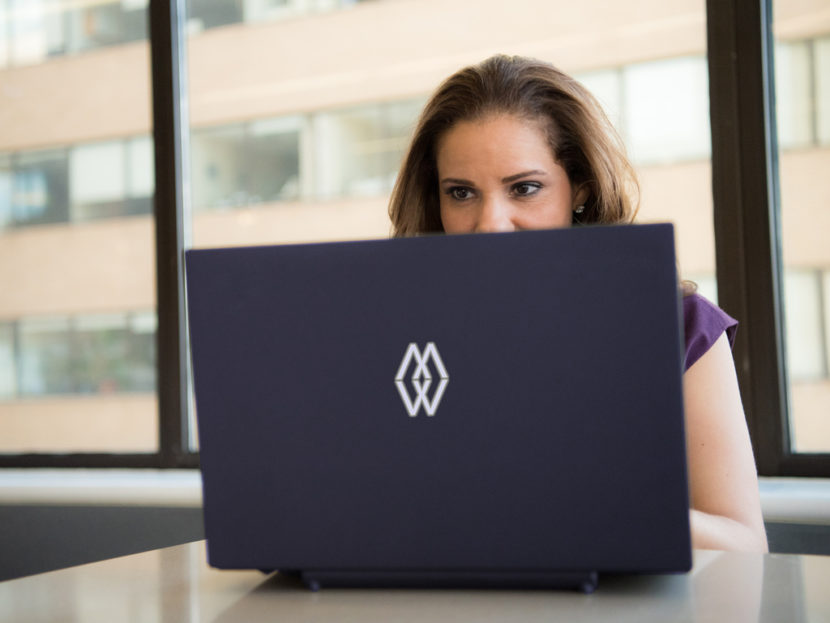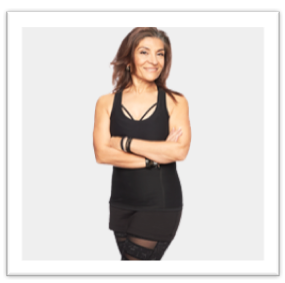These days it seems that more and more of us have jobs that entail sitting for hours on end, sometimes combined with a lengthy commute in a car where we’re sitting even longer. If you’ve seen the recent headlines, you know this is worrisome. Sitting has been linked to so many negative health consequences that it’s now being called the new smoking.

That’s why finding the time to get up and move during the day is absolutely necessary. And while there are a ton of different exercises you can do at your desk, the one that we’re currently loving is a Pilates workout. So we took a moment to chat with one of our master trainers, and she curated 5 moves that everyone can do at their desk (even if you work in a cube) — or really anywhere.
And we think you’ll love these exercises because Pilates not only helps you to move and tone up your body, but it may even help to reduce back pain, prevent injuries, create better posture and help you to become taller (really).
And according to our Life Time Director of Group Training and Pilates, Eduardo Perez, Pilates will also give you flat abs, improve muscle tone and lean muscle mass, and increase range of motion, flexibility and strength without putting stress on the joints.
But if you haven’t tried Pilates yet and you’re already working out, Perez says, Pilates can improve sport performance, reduce your risk of injury, aid in recovery time and build essential core strength. Ideally, you’d get a Pilates workout in 3 times per week, but if you already have a fitness program, 1 or 2 times per week will suffice.
And if you work one-on-one with a trainer, great. You may already be getting some of the benefits of Pilates, like strengthening your core and correcting movement dysfunctions with traditional fitness movements used in the Life Time Method. In fact, adding a single one-on-one session per week to your routine will vastly improve your movement pattern and ability.
If you currently do Pilates, you already know what we’re talking about, so we know you’ll want to check out this workout. If you’re new to Pilates, give these 5 moves a go — we know you’ll get hooked. And if you’d like to try out a Pilates class or one-on-one, click here.
THE ESSENTIAL PILATES DESK WORKOUT
by Mitra Callaghan
Most of us slouch over our desks, and stress can cause us to become shallow with our breathing. Doing Pilates can help to correct posture and reconnect us with our breath.
When people start Pilates, many of them don’t know how to breathe properly and they almost hyperventilate. It’s hard, but fully engaged breathing is important and it’s what we start with in Pilates — connecting to your breath.
Start each exercise below with 10 repetitions (each side when applicable) and add on more reps when ready or as needed.
1. BREATHING
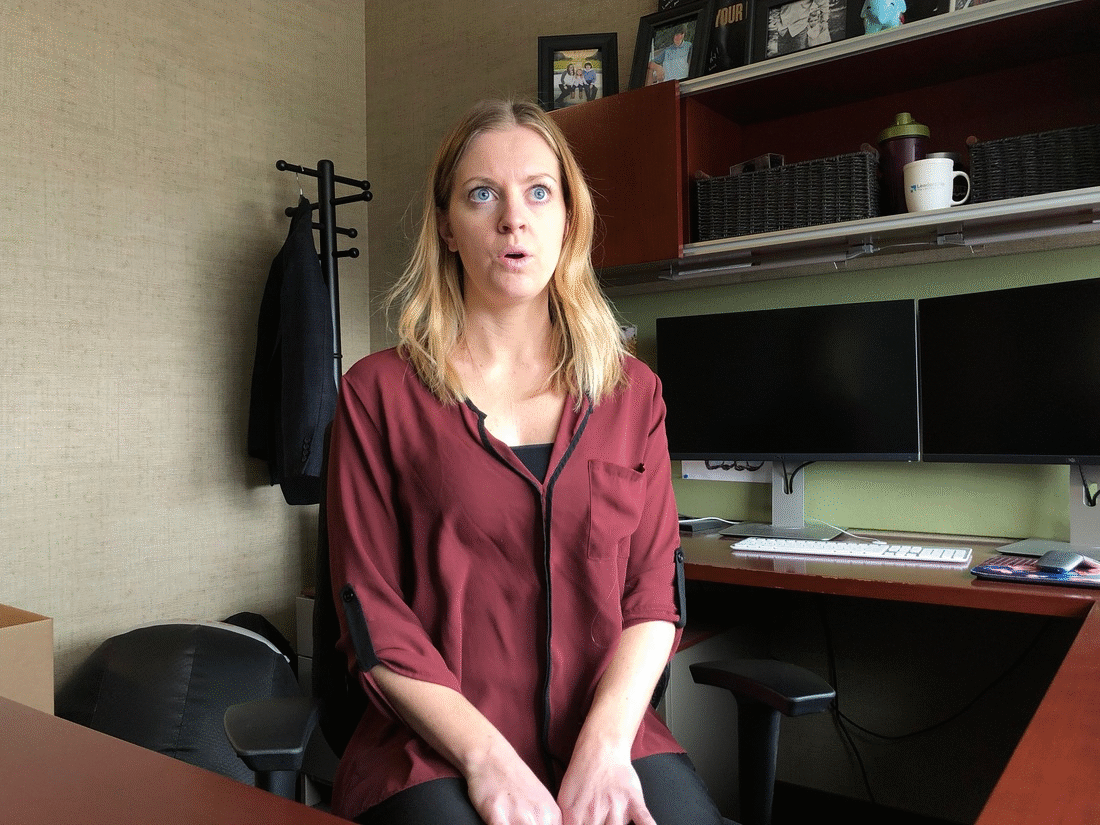
Start with how you are sitting: sit up straight, expand your chest, engage your upper back and think about zipping up your jacket (envision wearing a tight jacket and needing to zip it up).
Feel your feet on the ground, strong and grounded. Now close your eyes, open your mind and breathe. Breathe by inhaling through your nose — a big inhale — and expand your lungs until they are full. Then exhale all of it out through your mouth. Imagine extending your breath to the wall and having your rib cage pulling together like a corset. Then relax and drop your shoulders like a waterfall while you are lifting with the crown of your head, like you are being held up by a hanger.
So all together, you inhale fully, expand the chest and pull the belly to the back (zipping up the jacket), then exhale and relax your shoulders like a waterfall while pulling the crown of the head to the ceiling and pulling the belly to the back, creating a corset with the waist.
Visualize the whole thing and continue this breathing for 1 minute (or more). Remember what your posture feels like and you can come back to it throughout the day.
2. LEG LIFTS

Sitting at your desk at the edge of your chair, keep your legs wide, drop your arms and allow them to be heavy at your side.
Then elongate the spine and start breathing like we did in the first exercise. (Every time we elongate the spine in Pilates, we are creating space between the spine and creating length, which keeps the spine healthy.) Remember to pull the belly to the back and engage your core, or what we refer to as the powerhouse, and make sure not to dump the weight into the back.
Now that you’re sitting tall and breathing, start lifting your legs (from the belly), slowly and mindfully engaging the core. Lift one leg about 6 inches from the floor (not so high that you start getting into your hip flexors. Start with one leg and move to the other, remembering to engage the core.
3. EXTENDED ELBOW OR ARM PLANKS
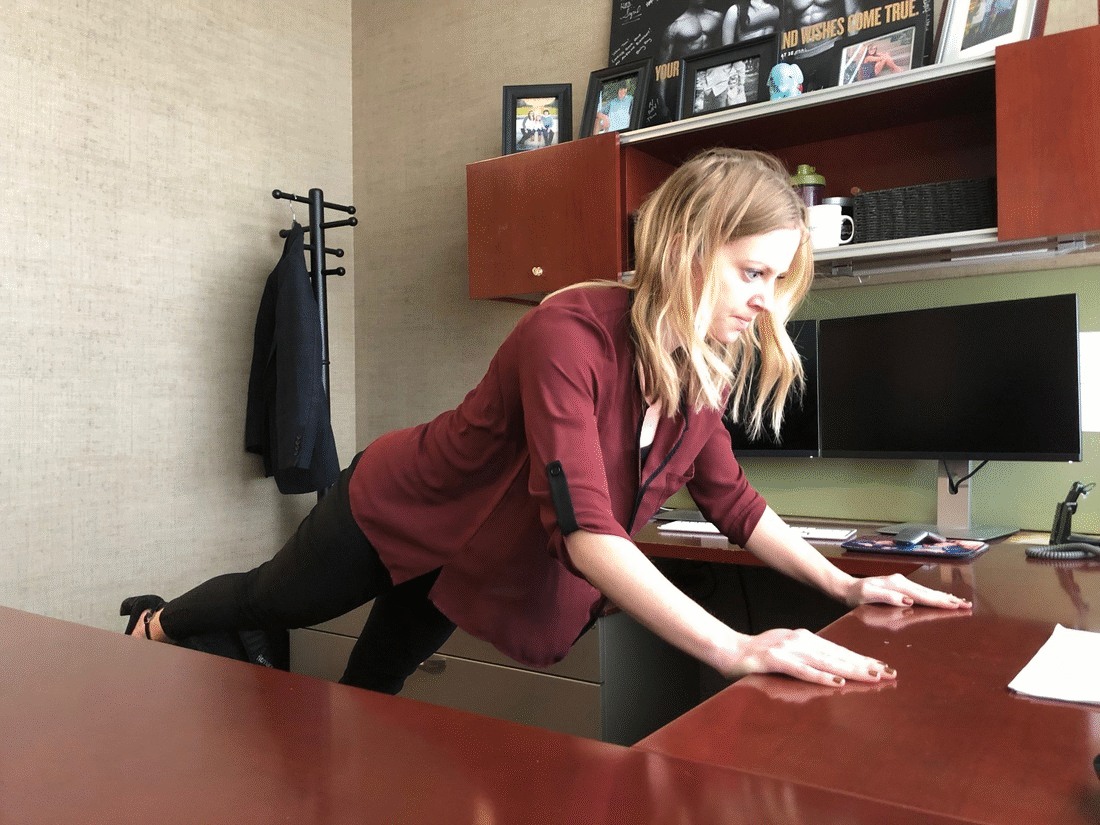
Using the edge of your desk, move your body out to a diagonal (plank position with your legs together, standing on your toes and stretching your calves).
You can also use your forearms if you have wrist issues. Using the same core muscles (always thinking about the core), bend your elbows slightly so as not to lock them, and then you are elongating your spine and your neck is in line.
Start by just holding this plank, engaging the core, and think about elongating again. Then to add on, starting with one leg, lift it up from the core and glute, point the toe out and pull it in from the belly.
Then add on again by holding the leg up and lowering the opposite heel. So you point the toes, lower the opposite heel, lift and elongate through the crown. Repeat: point, lower and lift. Then repeat with the opposite leg.
4. HIP OPENER
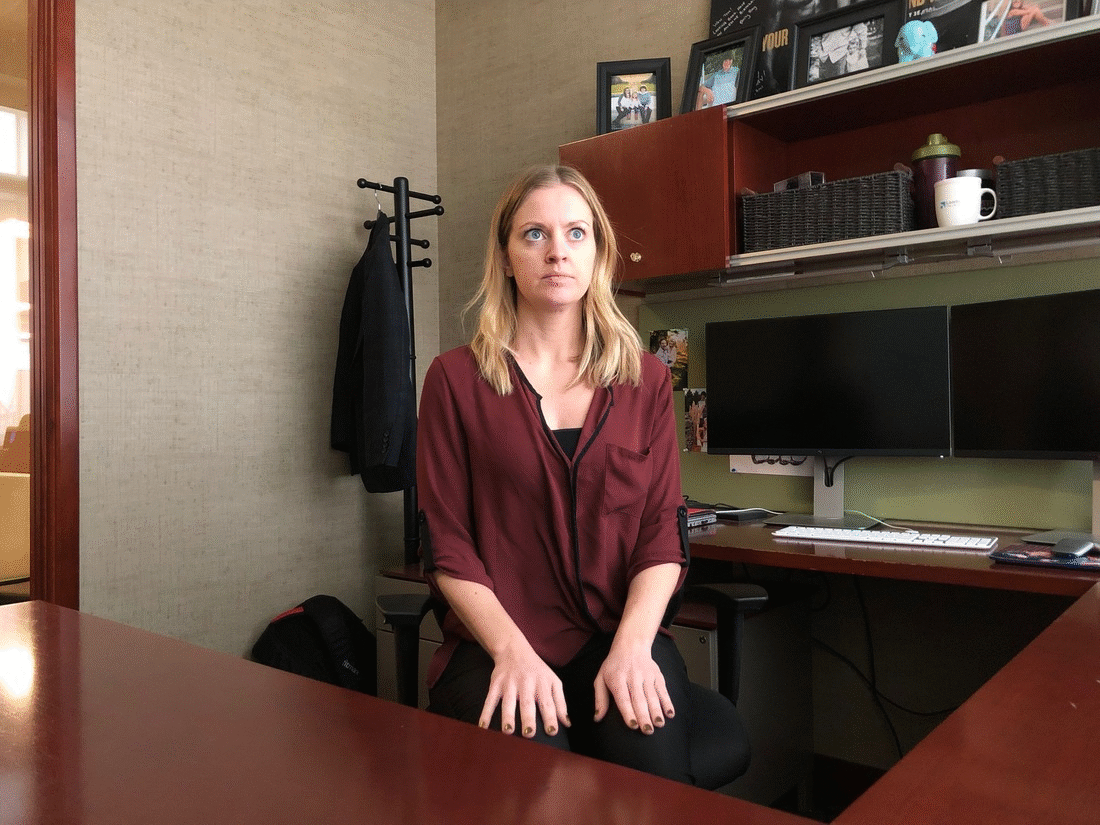
One amazing thing that Pilates helps people with is sitting at the desk without pain. We tend to dump into our lower backs (when we slouch and stop using our core) and then we say, “Oh my lower back is hurting.” When you have lower back pain, what is mostly hurting is the muscle around the lower back because the hip flexor is getting tighter. This exercise helps to loosen the hip flexor.
Sitting at the edge of the chair, sitting up straight and lengthening like we did with the other exercises (pulling the belly inward and reaching the crown upward while relaxing the shoulders), lift one leg on top of the other, with the ankle resting on the thigh so it’s at 90 degrees. One hand rests on the ankle and the other near the knee just as a support.
While continuing your breathing (in through the nose and out the mouth), gently push down on the knee area, taking care not to push too hard on the knee. As you push downward, keep a lengthened spine and neck, and you’ll bend forward while scooping the belly to the back and lifting from the sternum (what works in Pilates is opposition).
This will give you a good stretch in the hip flexor and glute. Hold for 5 seconds breathing in and out, then lift the spine back up using the core. Release the leg, then move on to the other leg and repeat.
5. DESK SQUATS
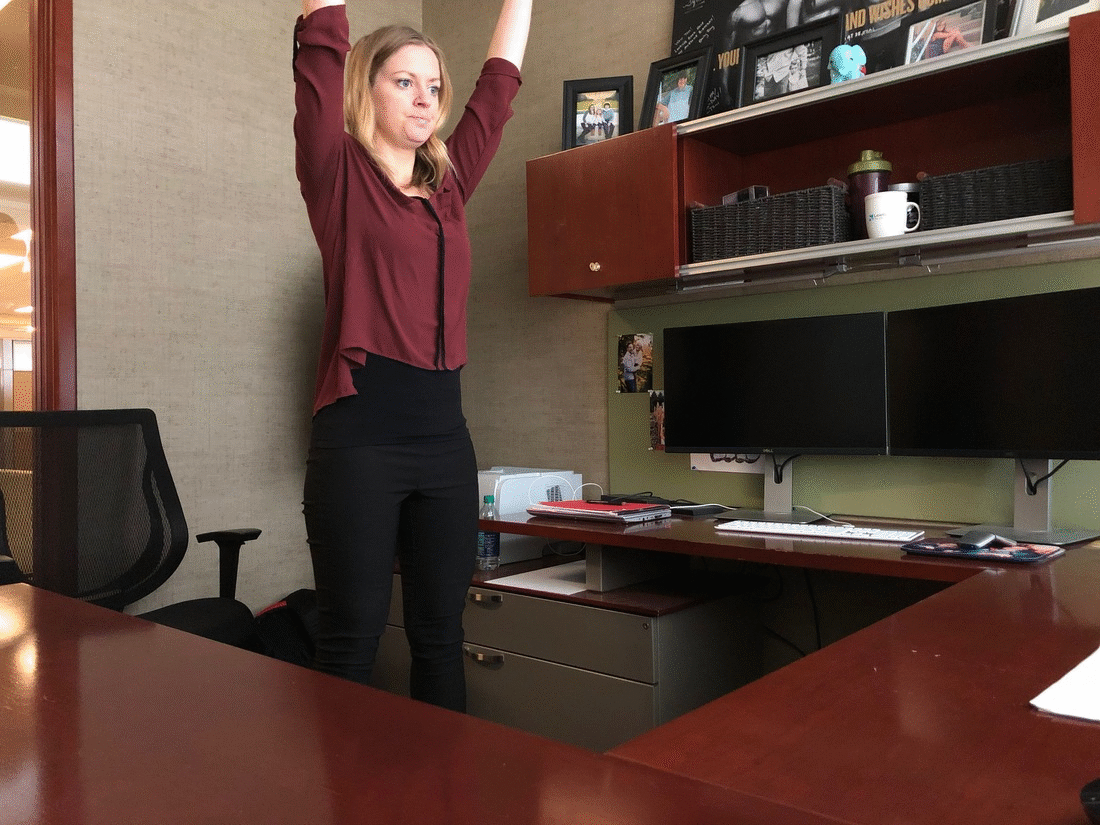
Start standing and keep your legs as wide as you want. Using your core, reach your arms up (either near your ears and upward to the ceiling or outward towards the wall, depending on your mobility). Using your torso (watch that you aren’t pulling your shoulders into your ears), sit back with your bottom like you are sitting in a chair (being careful not to overextend your knees over your toes).
BONUS: HOW TO SIT BETTER AT YOUR DESK
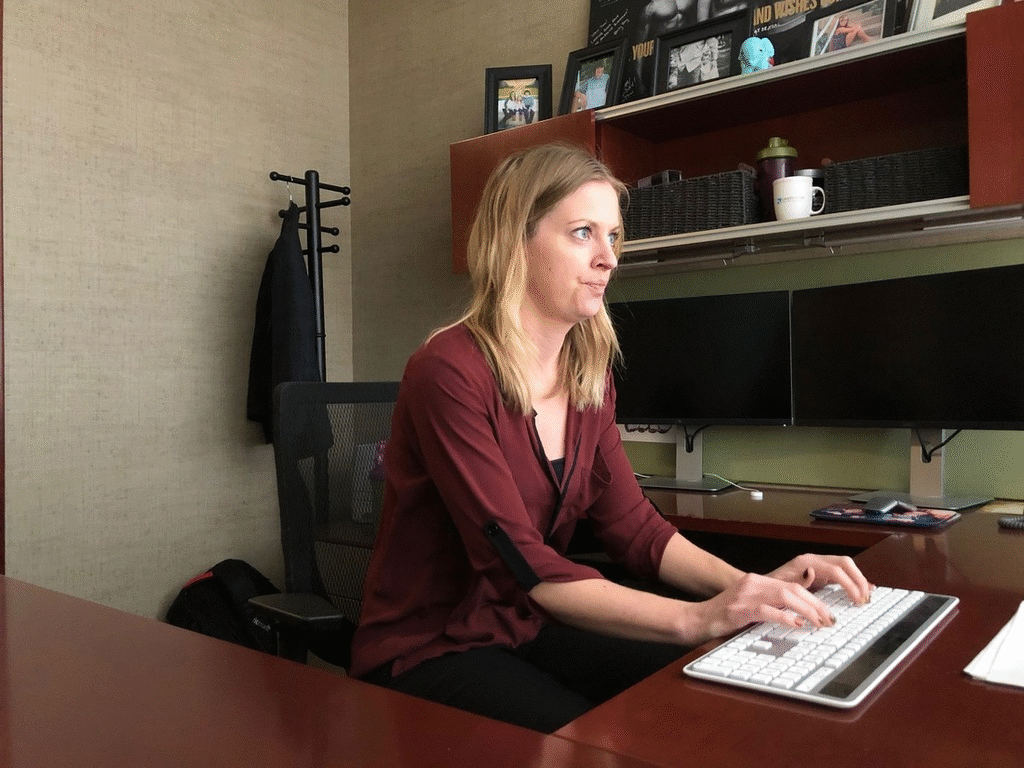
First, make sure you are sitting upright with your feet on the ground. The computer should be at your eye level.
Now scoop your belly to the back, reach the crown upward and lengthen, then waterfall your shoulders so your shoulders are not in your ears, and keep your chest open so you are not slouching. Remember how this feels.
Then when you find yourself slouching during the day, just return to this position. You’ll breathe better and in turn feel better, and you’ll be putting less strain on your neck and lower back, too.
MEET THE TRAINER
NAME: Mitra Callaghan
LOCATION: Life Time, Chanhassen, MN
POSITION: Pilates coordinator, master trainer + nutrition coach
Q + A
Q. How did you find yourself in your current position?
A. “Fifteen years ago, we moved to Minneapolis from Chicago and I had a small child. I said, ‘I’m going to stay home and change my career,’ and that brought my passion back. I was going to reinvent myself. I was in the retail world before and was doing awesome and making money, but I said I would take a step back and see if I can help myself.
“I was always active. And if I’m getting older, what do I want to do for myself? Then I became a personal trainer. I got my certificate and found out the Chanhassen Life Time location was hiring. Then I got hired in Bloomington, but I knew I wanted to be in Chanhassen.
“[At that point] I didn’t know anything about Pilates. And they opened the first Pilates studio and it was new to almost everybody. They built a small studio with five reformers in Chanhassen, and I took my first Pilates class, and got addicted and knew I wanted to get certified.
“I’m a learner — that’s my passion. Everything they put out there I want to do. I’m also certified as a nutrition coach. Everything that is core [with Pilates] — I like that. If you fix those muscles you can prevent injuries. If the hips open up, the hamstrings aren’t as tight. This is my philosophy. You are going to have pain, but let’s get rid of it by moving correctly. Joseph Pilates said, ‘Change happens through movement and movement heals.’”
Q: How do you keep fit?
A. “Exercise. Pilates fixes everything. It actually helped a cancer patient. Because you are in your mind. And the miracle of positive self-talk — it goes beyond.
“I do Pilates 3 times per week, once a week strength training and I watch my nutrition. This summer I will add in one more day of strength training.”
Q. What’s one thing you wish you could tell everyone?
A. “It’s about how you bounce back. Know how high you went up and how low you go down — so you know how to bounce back. It doesn’t matter how old you are [and] it’s never too late to start or to go after your passion.”
Q. Do you have an ideal client?
A. “People who listen. [They] need to be open-minded. Be consistent and ‘follow the yellow brick road,’ you go one step at a time.”
Q. Last words of wisdom . . .
A. “To make a change, you need to do it for 40 days to build the habit and change something. Everything is connected, nutrition, strength training. Then we have to do Pilates to get our sanity back, it helps to connect the body and mind. Joseph Pilates said, ‘In 10 sessions, you feel better, 20 sessions you look better, 30 sessions you have a completely new body.’”
Click here to learn more about Mitra.
Written by LTWL Staff and workout by Mitra Callaghan — Pilates coordinator — Life Time, Chanhassen, MN
This article is not intended for the treatment or prevention of disease, nor as a substitute for medical treatment, nor as an alternative to medical advice. Use of recommendations in this and other articles is at the choice and risk of the reader.


